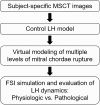New insights into mitral heart valve prolapse after chordae rupture through fluid-structure interaction computational modeling
- PMID: 30470812
- PMCID: PMC6251907
- DOI: 10.1038/s41598-018-35555-5
New insights into mitral heart valve prolapse after chordae rupture through fluid-structure interaction computational modeling
Erratum in
-
Author Correction: New insights into mitral heart valve prolapse after chordae rupture through fluid-structure interaction computational modeling.Sci Rep. 2019 Jun 27;9(1):9558. doi: 10.1038/s41598-019-44072-y. Sci Rep. 2019. PMID: 31249319 Free PMC article.
Abstract
Mitral valve (MV) dynamics depends on a force balance across the mitral leaflets, the chordae tendineae, the mitral annulus, the papillary muscles and the adjacent ventricular wall. Chordae rupture disrupts the link between the MV and the left ventricle (LV), causing mitral regurgitation (MR), the most common valvular disease. In this study, a fluid-structure interaction (FSI) modeling framework is implemented to investigate the impact of chordae rupture on the left heart (LH) dynamics and severity of MR. A control and seven chordae rupture LH models were developed to simulate a pathological process in which minimal chordae rupture precedes more extensive chordae rupture. Different non-eccentric and eccentric regurgitant jets were identified during systole. Cardiac efficiency was evaluated by the ratio of external stroke work. MV structural results showed that basal/strut chordae were the major load-bearing chordae. An increased number of ruptured chordae resulted in reduced basal/strut tension, but increased marginal/intermediate load. Chordae rupture in a specific scallop did not necessarily involve an increase in the stress of the entire prolapsed leaflet. This work represents a further step towards patient-specific modeling of pathological LH dynamics, and has the potential to improve our understanding of the biomechanical mechanisms and treatment of primary MR.
Conflict of interest statement
Dr. Wei Sun serves as the Chief Scientific Advisor of Dura Biotech. He has received compensation and owns equity in the company. The other authors declare no competing interests.
Figures









References
-
- Grande-Allen KJ, Ratliff NB, Griffin B, Cosgrove D, 3rd, Vesely I. Case report: outer sheath rupture may precede complete chordal rupture in fibrotic mitral valve disease. The Journal of heart valve disease. 2001;10:90–93. - PubMed
-
- Nelson, J. S. & Bolling, S. F. In Seminars in thoracic and cardiovascular surgery. 1–4 (Elsevier). - PubMed
Publication types
MeSH terms
Grants and funding
- R21 HL127570/HL/NHLBI NIH HHS/United States
- 15POST25910002/American Heart Association (American Heart Association, Inc.)/International
- HL127570/U.S. Department of Health & Human Services | NIH | National Heart, Lung, and Blood Institute (NHLBI)/International
- R01 HL104080/HL/NHLBI NIH HHS/United States
- HL104080/U.S. Department of Health & Human Services | NIH | National Heart, Lung, and Blood Institute (NHLBI)/International
LinkOut - more resources
Full Text Sources
Medical
Molecular Biology Databases

